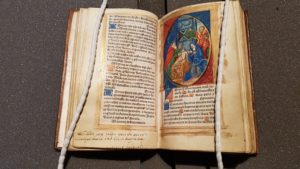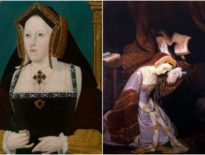Thank you so much to Tudor Society member Corinna Hahn for asking the following question for our "Expert Answers" section. It's a very interesting question.
I (Claire) opted to answer this one as I've done lots of research on the two books of hours in the collection at Hever Castle, and I was lucky enough to hold them and talk to my dear friend, castle supervisor, Owne Emmerson, about them back in May. I've included the video below my answer so that you can find out all about these beautiful books.
Here is Corinna's question in full:
"I've got some questions about one book of hours that Anne Boleyn owned and that is now at Hever Castle. It's the one with Anne Boleyn's inscription under a prayer adjacent to a miniature of the presentation of Jesus in the temple. The inscription reads "Remember me when you do pray that hope doth lead from day to day."
This rhyme has intrigued me for years, since we don't know when and where Anne wrote it, to whom she wrote it and what the real message behind her inscription was.
It seems to me that Anne didn't write in her prayer books heedlessly, every inscription she has left somewhere is there for a reason and where she placed her "Remember me" rhyme could possibly be a clue to the point of time when she wrote these words.
My questions are: Under which text did she write her "Remember me" rhyme? Is there a transcription and/or translation of this text? Why did she place her message there? Was the rhyme she wrote meant as a prayer request or a farewell to someone? Is it known who owned the prayer book after her death? Where was the book before Hever Castle acquired it?"
Photo of the page in question (photo by Claire Ridgway, with thanks to Hever Castle) - click to enlarge:
Answer
The inscription "Remember me when you do pray that hope doth lead from day to day" appears on the bottom of a page in a Book of Hours that was produced in Paris in 1528, and is the later of the two Hever Castle books of hours that belonged to Anne. Taking into account its production date, it seems likely that it was in her possession when she was Henry VIII's queen consort, from 1533-1536.
As Owen Emmerson points out in the video that you'll find at the bottom of this article, the "Remember me" inscription is often described as accompanying the image of the coronation of the Virgin. This is due to a mistake in Eric Ives' "The Life and Death of Anne Boleyn". The inscription is actually at the bottom of the page facing an illumination of the Presentation in the Temple. Owen explained to me that the placement of the inscriptions alongside illuminations has meaning, they are not random. Owen points out that in the British Library Book of Hours which has inscriptions by Henry VIII and Anne Boleyn, Henry's inscription "If you remember my love in your prayers as strongly as I adore you, I shall hardly be forgotten, for I am yours. Henry R forever" is about him suffering in his love for Anne, he is love-sick, and this inscription is next to an image of Christ suffering. Anne Boleyn's inscription, "Be daly prove you shall me fynde, To be to you bothe lovynge and kynde", or "By daily proof you shall me find To be to you both loving and kind", is under an image of the Anunciation, the Angel Gabriel telling Mary that she would have a son, so Anne was sending a clear message to Henry VIII about her intention to give him what he wanted, a son. Both the inscriptions and the illustrations send a message. The British Library book was being used by two people, Henry and Anne, to communicate, whereas the Hever book inscriptions were personal to Anne and Owen feels that "we can theorise here is that Anne is asking for hope for a male heir, for the succession, and to be remembered in people's prayers for that particular end." That certainly makes sense with the accompanying illustration.
Regarding the history of the book, Owen explained that the Remember me book was purchased by William Waldorf Astor sometime before 1919. Astor purchased Hever in 1903 and was good at collecting Boleyn-related material. Owen is going to try and find out what is known about the book's location between it being in Anne Boleyn's possession in the 1530s and Astor buying it in the 1900s.
As for the text on the page of Anne's inscription, it is in Latin and the top part of the page is from the Hour of the Cross for the morning (Verses for Sext, invoking Christ’s crucifixion) and the Hour of the Compassion for the morning (Verses for Sext, invoking the grief of the Virgin Mary as she watched the crucifixion of her son). The Little Office of the Blessed Virgin Mary, or the Hours of the Virgin, were, as the Met Museum explains, “a set of prayers in eight sections meant to be said at regular intervals throughout the twenty-four-hour day”. These books were designed for lay people and were inspired by the devotions at the canonical hours of monks and nuns. The owner of the book of hours would read and recite the series of prayers and praise for the Virgin Mary throughout the day, at the canonical hours - Matins, Lauds, Prime, Terce, Sext, None, Vespers, and Compline. These books were for personal devotion. Susan M. Felch, editor of Elizabeth Tyrwhit's Morning and Evening Prayers, explains that books of hours were “compendia of written prayers” and quotes Virgina Reinburg as saying that “Devout medieval people collected prayers the way twentieth century cooks collect recipes”, so these books were unique in their supplementary prayers, although they would all have the Little Office of the Blessed Virgin Mary as their “centerpiece” and were therefore mainly “derived from the public liturgy”, which both lay people and religious people would have been familiar with.
The two “hours” on the page with the description are for Sext, which was said at noon. Bryn Mawr College website, in an article on the Hours of the Virgin, explains that “Illustrations for the Office of the Virgin consist of either the Infancy Cycle, which depicts Mary's role in the conception, birth, and childhood of Christ, or the Passion Cycle, which depicts his death and rebirth” and that the Little Hours, i.e. terce, sext and none, tended to have Psalms but that in some cases they would “employ the Passion Cycle images throughout the Hours of the Virgin, allowing users to meditate on the Biblical events that culminate in the Crucifixion and Resurrection – and the forgiveness of human sins.” For sext, Anne’s Book of Hours features an illustration of the Presentation of Jesus at the temple in Jerusalem, which is described in Luke Chapter 2. Mary takes centre stage in this image.
Here is the Latin text from the page of the inscription:
“Adoramus te christe et benedicimus tibi: quia per sanctam crucem tuam redemisti mundum. Oremus.
Domine iesu christe fili dei vivi pone passionem crucem et mortem tuam inter iudicium tuum et animas nostras nunc et in hora mortis nostre et largiri digneris vivis misericordiam et gratiam defunctis veniam et requiem ecclesie tue pacem et concordiam et nobis peccatoribus vitam et gloriam sempiternam. Qui vivis et regnas deus. Per omnia secula seculorum. Amen.
Gloriosa passio domini nostri iesu christi eruat nos a dolore tristi et perducat nos ad gaudia paradisi. Amen.
Ad sextam de compassione
Hora sexta respicit mater suum natum. Obsitum vulneribus in cruce levatum. Inter fures positum
felleque potatum. Illa secum centies reddit eiulatum. ãn.
Te laudamus te rogamus mater iesu christi. Ut intendas et defendas nos a morte tristi. Oremus.
Domine sancte iesu fili dulcis virginis marie qui pro nobis mortem in cruce tolerasti
fac nobiscum misericordiam tuam: et da nobis et cunctis compassionem tue sanctissime matris
devote recolentibus eius amore huius seculi vitam in presenti gratiosam et tua pietate gloriam
in futuro sempiternam. In qua vivis et regnas deus. Per omnia
Ad nonam de beata maria.”
And here is a translation of that text done by Thomas Hockings, commissioned by Tim:
"We worship you O Christ and we bless you: because through your holy cross you
redeemed the world. Let us pray.
Lord Jesus Christ, son of the living God, put your passion
may the the glorious passion of our Lord Jesus Christ deliver us from sad pain and lead us to the joys of paradise. Amen.
For the sixth [the hour of] about compassion
On the sixth hour the mother looks on her son. Beset with wounds raised on the cross. Placed among thieves and offered bile (or poison/bitterness) to drink. She [Mary] laments to herself a hundred times. Amen.
We praise you we beseech you mother of Jesus Christ. So you may look on us and defend us from sad death. Let us pray.
Holy Lord Jesus son of the sweet virgin Mary who endured death for us on the cross grant your mercy to us: and give to us and all the compassion of your most holy devoted mother who reflect with her love of this age on life gracious in [her] presence [and] glory lasting to eternity with your piety. In whom you live and reign as God. For ever...
[For the ninth hour concerning the blessed Mary]."
And here is the video of Owen and I discussing the Hever Books of Hours:
Sources
- Hours of the Virgin Mary - http://www.brynmawr.edu/library/exhibits/hours/virgin.html
- The Sarum Hours - http://manuscripts.org.uk/chd.dk/inc/perg19.html
- Tutorials on books of hours - http://manuscripts.org.uk/chd.dk/tutor/index.html, http://manuscripts.org.uk/chd.dk/tutor/index.html#hcrux, http://manuscripts.org.uk/chd.dk/tutor/HSCruce.html
- The Book of Hours: A Medieval Bestseller - https://www.metmuseum.org/toah/hd/hour/hd_hour.htm
- Elizabeth Tyrwhit's morning and evening prayers, Susan Felch, Ashgate Publishing
- Anne Boleyn Book of Hours - https://www.bl.uk/collection-items/anne-boleyn-book-of-hours
- Hever Castle Books of Hours - https://www.hevercastle.co.uk/news/castle-object-of-the-month-books-of-hours/




This as very interesting. Thank you! Michelle t
Thank you, Claire, for your wonderful article on this beautiful inscription and prayer book belonging to Anne Boleyn.
Thank you so much, Claire, for your very detailed and highly informative answer to my book of hours question. I am thrilled!
It’s a pleasure. These books fascinate me and I was so lucky to get to hold them.
hi. my name is nicola jayne brown mild down syndrome i am interested in anne boleyn and her cousin katheryn howard and the family decided